
USS Tarawa (LHA-1), the lead ship of her class, is an amphibious assault ship that served in the United States Navy from 1976 to 2009. She is the second ship to be named for the Battle of Tarawa, fought during World War II. Tarawa was decommissioned on 31 March 2009, at San Diego Naval Base.
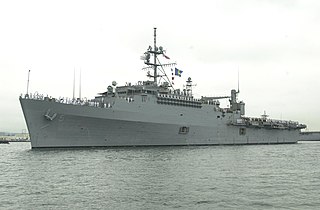
USS Ogden (LPD-5), an Austin-class amphibious transport dock, was the second ship of the United States Navy to be named for Ogden, Utah. Ogden was laid down on 4 February 1963 by the New York Naval Shipyard. She was launched on 27 June 1964 sponsored by Mrs. Laurence J. Burton, and commissioned at New York City on 19 June 1965.

USS Cleveland (LPD-7), an Austin-class amphibious transport dock, was the third ship of the United States Navy to be named for the city in Ohio. Her keel was laid down at Ingalls Shipbuilding of Pascagoula, Mississippi. She was launched on 7 May 1966, and was commissioned on 21 April 1967 at Norfolk, Virginia. At the time of decommissioning, she was the third-oldest commissioned ship in the US Navy, behind USS Constitution and USS Enterprise (CVN-65).

USS New Orleans (LPD-18), a San Antonio-class amphibious transport dock, is the fourth commissioned ship of the United States Navy to be named after the city of New Orleans, Louisiana.
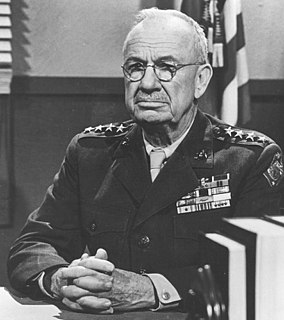
Holland McTyeire "Howlin' Mad" Smith, KCB was a general in the United States Marine Corps during World War II. He is sometimes called the "father" of modern U.S. amphibious warfare. His nickname, "Howlin' Mad" Smith, had been given to him by his troops in the Dominican Republic in 1916.
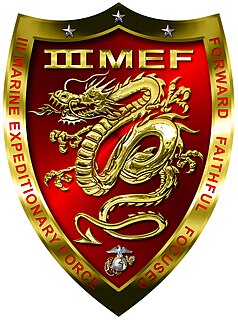
III Marine Expeditionary Force is a formation of the Marine Air-Ground Task Force of the United States Marine Corps. It is forward-deployed and able to rapidly conduct operations across the spectrum from humanitarian assistance and disaster relief (HA/DR) to amphibious assault and high-intensity combat.
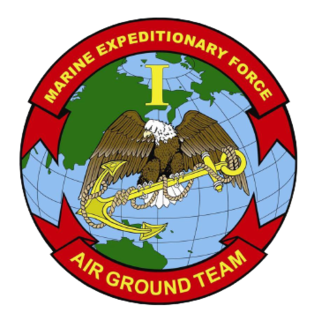
The I Marine Expeditionary Force is a Marine Air Ground Task Force (MAGTF) of the United States Marine Corps primarily composed of the 1st Marine Division, 3rd Marine Aircraft Wing, and 1st Marine Logistics Group. It is based at Marine Corps Base Camp Pendleton.

The 2nd Marine Regiment is an infantry regiment of the United States Marine Corps. They are based at Marine Corps Base Camp Lejeune, North Carolina and fall under the command of the 2nd Marine Division and the II Marine Expeditionary Force.
Marine Air-Ground Task Force is a term used by the United States Marine Corps to describe the principal organization for all missions across the range of military operations. MAGTFs are a balanced air-ground, combined arms task organization of Marine Corps forces under a single commander that is structured to accomplish a specific mission. The MAGTF was formalized by the publishing of Marine Corps Order 3120.3 in December 1963 "The Marine Corps in the National Defense, MCDP 1-0". It stated:

The 1st Battalion, 6th Marines (1/6) is an infantry battalion in the United States Marine Corps based in Camp Lejeune, North Carolina. It consists of approximately 1,100 marines and sailors. They fall under the command of the 6th Marine Regiment, the 2nd Marine Division of the II Marine Expeditionary Force.

2nd Combat Engineer Battalion is a combat engineer battalion of the United States Marine Corps. They are based out of Marine Corps Base Camp Lejeune, North Carolina and fall under the command of the 2nd Marine Division and the II Marine Expeditionary Force.

USS Mount McKinley (AGC-7/LCC-7) was the lead ship of the Mount McKinley class of amphibious force command ships. She was named after the highest mountain in North America. She was designed as an amphibious force flagship, a floating command post with advanced communications equipment and extensive combat information spaces to be used by the amphibious forces commander and landing force commander during large-scale operations.
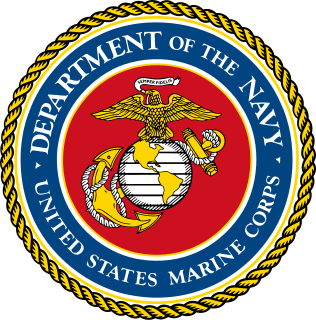
The United States Marine Corps is organized within the Department of the Navy, which is led by the Secretary of the Navy (SECNAV). The most senior Marine commissioned officer is the Commandant of the Marine Corps, responsible for organizing, recruiting, training, and equipping the Marine Corps so that it is ready for operation under the command of the unified combatant commanders. The Marine Corps is organized into four principal subdivisions: Headquarters Marine Corps, the Operating Forces, the Supporting Establishment, and the Marine Forces Reserve.
A Marine expeditionary brigade (MEB) is a formation of the United States Marine Corps, a Marine air-ground task force of approximately 14,500 Marines and sailors constructed around a reinforced infantry regiment, a composite Marine aircraft group, a combat logistics regiment and a MEB command group. The MEB, commanded by a general officer, is task-organized to meet the requirements of a specific situation. It can function as part of a joint task force, as the lead echelon of the Marine expeditionary force (MEF), or alone. It varies in size and composition, and is larger than a Marine expeditionary unit (MEU) but smaller than a MEF. The MEB is capable of conducting missions across the full range of military operations.

Expeditionary Strike Group 3 is an expeditionary strike group (ESG) of the U.S. Navy. Expeditionary strike groups combine the capabilities of surface action groups, submarines, and maritime patrol aircraft with those of Amphibious Ready Groups for deployment and maintaining staff proficiencies to provide fleet commanders with a highly flexible, ready fly-away unit. It is capable of projecting expeditionary striking power in the maritime, littoral, and inland environs in support of U.S. national interests.

The 3rd Marine Expeditionary Brigade is a United States Marine Corps unit that is the "middleweight" crises response force of choice in the Pacific Area of Operation. It is the Marine Corps’ only permanently forward-deployed Brigade sized Marine Air-Ground Task Force and is a resilient, ready and relevant force able to rapidly deploy and conduct operations across the spectrum from humanitarian assistance and disaster relief to amphibious assault and high intensity combat. 3d MEB maintains a forward presence in the Pacific Theater to support contingencies and alliance relationships. 3d MEB also conducts combined operations and training throughout the region in support of United States national security strategy.

1st Marine Expeditionary Brigade is a unit in the I Marine Expeditionary Force and is the "middleweight" global crisis response force.
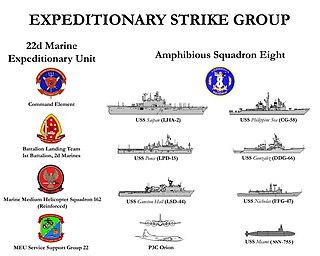
The expeditionary strike group (ESG) is a United States Navy concept introduced in the early 1990s, based on the Naval Expeditionary Task Force. The U.S. Navy fields nine expeditionary strike groups and ten carrier strike groups (CSGs), in addition to surface action groups. ESGs allow the U.S. to provide highly movable and self-sustaining naval forces for missions in various parts of the world.
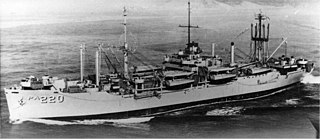
USS Okanogan (APA/LPA-220) was a Haskell-class attack transport that saw service with the US Navy in World War II, the Korean War and the Vietnam War. She was of the VC2-S-AP5 Victory ship design type and named after Okanogan County, Washington.
The 4th Marine Expeditionary Brigade was a brigade-sized unit of the United States Marine Corps that was designed specifically to be an anti-terrorism unit. The mission of this unit was to be a quickly deployable unit to wherever needed in the world so they could fight terrorism and deter, detect and defend from terrorist groups both domestically and internationally. The unit became operational on 29 October 2001, and was deactivated in February 2006.




















